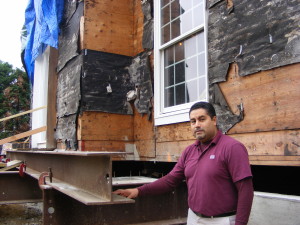After the flood, waterfront homes get a lift
On Philips Lane in Rye, a crew from Murphy Brothers Contracting Inc. is doing a full renovation this fall on a Sound Shore home that was only narrowly spared from the rising flood of Hurricane Sandy a year ago. Some of the recent interior work went on while the million-dollar-plus house sat on steel crossbeams that raised it nearly two feet off its foundation. In Sandy”™s wake, the house raising has become a familiar waterfront sight on Long Island Sound from Connecticut to Long Island.
Some homeowners have been required by property insurers and mortgage lenders to move their structures above the base flood-elevation levels mapped by the Federal Emergency Management Agency (FEMA). For the owner of the gutted and lifted house in Philips Lane, “I think that she wanted peace of mind too,” said Miguel Palma, site supervisor for Murphy Brothers. The house when lowered to its foundation will be 11 inches higher than its precarious perch last year above Sandy”™s high water mark on the property.
At Nicholas Brothers Inc., a structural moving company in Hopewell Junction, the demand from homeowners in Rye and other Sound Shore communities has kept two work gangs busy. It has drawn other house raising and moving contractors from “all over the country” and Canada, said company president John D. Nicholas.
“Probably 90 percent of what we”™re doing right now is all related to Sandy,” he said. “We”™ve got work all along the coastline, all through Connecticut, Long Island, New York.” Nicholas said the family-owned business has four or five jobs pending in Greenwich “and more to do in Rye.”

“The mortgage companies, some want it,” he said of the house raisings. “The banks, some want it.”
Depending on flood zone requirements in their municipalities, some houses have been moved back two to four feet on their waterfront tracts. “They”™re not big moves,” Nicholas said.
On Long Island, “We”™re lifting houses up and they”™re driving piles under them. We”™re lifting houses 16 feet.”
The cost of a house lifting like that done by Nicholas Brothers on Philips Lane typically ranges from $30,000 to $40,000, Nicholas said. “Some people are using their own money” to pay for the work, he said. “Some people are using flood insurance money. Some people are getting money from the states. Some people really have to rely on FEMA.”
“It”™s a lot of paperwork for when you want to get money from different places,” Nicholas said. “You”™ve got to be patient and fight the system. They don”™t make it as easy as they make it sound on TV.”
Nicholas does not expect his company”™s disaster-related work to dry up soon.
“From what they”™re telling me, it sounds like a three- to four-year window. On Long Island, it”™s just block after block, house after house” in need of a structural lift.
Yet one year later, Hurricane Sandy and fears of more major flooding that rose in its wake have not affected Sound Shore real estate trends, according to one broker in Westchester”™s high-end housing market.
“We sold a number of waterfronts without any issue,” said Judi Smith, branch manager and associate broker in the Rye office of Houlihan Lawrence. “There are more on the market than usual but not necessarily because of Sandy, but because people have heard the prices are up.”
Smith noted the Westchester market historically has seen a six-month lull in real estate deals after floods. But brokers did not see that usual slowdown after Sandy.
“I think the effect has been surprisingly minimal,” Smith said. “People still want to live on the waterfront. There still seems to be an appetite for waterfront homes. We”™ve sold them and we”™ve sold them at good prices.”
“The biggest unknown is flood insurance rather than the fear of another storm,” Smith said. As of Oct. 1, FEMA subsidies ended for flood insurance coverage on older homes, she said. “We haven”™t heard yet how high the insurance will be.”
Rising costs for flood insurance should not affect the Sound Shore”™s luxury market, Smith said, “If you can pay $7 million for a house, I don”™t think you worry about it that much.” Many owners of luxury homes do not have a mortgage and are self-insured, she said.
Still, the worker noted, properties on the Sound Shore are not exclusively luxury homes. Those homeowners will be affected by rising insurance premiums.
In the real estate market, “The only thing that really hurts us is uncertainty,” Smith said. “There”™s uncertainty about flood insurance now.”
In the village of Mamaroneck on the Sound Shore, “We haven”™t seen very many people trying to elevate their homes,” Village Manager Richard Slingerland said.
Village officials were aware of the community”™s base flood elevations computed by FEMA before Sandy struck, he noted. Those calculations are used to prepare FEMA”™s still-pending flood insurance rate maps for communities, which identify special hazard areas and risk zones that determine national flood insurance premium rates.
“Once they are adopted, I think they will have an impact on base flood elevations” in Mamaroneck, he said.
Slingerland said buildings in the village”™s waterfront parks “had some significant damage” from Sandy. The work of repairing them “is still in process. It”™s been a long process” as the village has been slowed by its efforts to comply with regulatory requirements, he said.